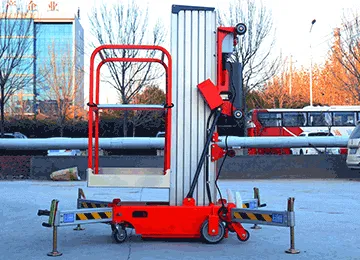As construction projects grow in complexity and scale, the need for efficient, reliable, and adaptable vertical transportation solutions has never been more critical. Mast Elevator, known for their flexibility and adaptability, have emerged as a vital component in the construction and industrial sectors. But as technology continues to evolve, so too does the potential for mast elevators to push the boundaries of what vertical transportation can achieve.
This blog will explore the exciting innovations shaping the future of mast elevators, focusing on custom designs that address the unique needs of modern projects. From smart automation to eco-friendly solutions, these advancements are redefining the standards for vertical mobility.
Why Mast Elevators Are Becoming the Go-To Solution
Before diving into the innovations, it’s essential to understand why mast elevators have become a preferred choice for many construction and industrial applications. Unlike traditional lifts that require extensive infrastructure, mast elevators offer:
- Quick and flexible installation: Their modular design allows for rapid assembly and disassembly.
- Customizable configurations: Platform size, load capacity, and mast height can be tailored to the project’s needs.
- Adaptability: They can operate in tight spaces or challenging environments where conventional elevators cannot.
These advantages make mast elevators ideal for projects ranging from high-rise construction to infrastructure maintenance and everything in between. As demand grows for more specialized and versatile lifting solutions, innovators are pushing the boundaries of what mast elevators can do.
Key Innovations in Custom Mast Elevators
Here are some of the most exciting trends and innovations that are shaping the future of mast elevators:
1. Smart Technology Integration
Automation and smart controls are revolutionizing the operation of mast elevators. As construction sites increasingly adopt digital solutions, mast elevators are following suit by integrating advanced control systems that enable:
- Remote Monitoring and Control: Operators can now monitor the elevator’s status, track performance data, and even control the lift remotely using mobile apps or cloud-based platforms. This not only enhances safety but also improves operational efficiency by reducing manual intervention.
- AI-Driven Predictive Maintenance: With sensors embedded in critical components, mast elevators can predict when maintenance is needed before a failure occurs. AI algorithms analyze performance data in real-time, identifying patterns that suggest wear and tear. This proactive approach minimizes downtime and extends the lifespan of the elevator.
- Automated Operation: In certain applications, fully automated mast elevators can be programmed to transport materials or workers to specific floors or areas without requiring manual input. This reduces delays and ensures a smooth flow of operations, especially in fast-paced environments like high-rise construction.
2. Eco-Friendly and Energy-Efficient Designs
Sustainability is at the forefront of modern construction practices, and mast elevators are no exception. Innovators are focusing on creating more environmentally friendly solutions by incorporating:
- Energy-Efficient Motors: Advanced motor technology reduces power consumption while maintaining high performance. Regenerative braking systems can even convert kinetic energy back into electrical energy, further improving efficiency.
- Lightweight Materials: Using sustainable, high-strength materials like carbon fiber or aluminum alloys reduces the overall weight of the elevator, leading to lower energy consumption and easier installation.
- Solar-Powered Options: In outdoor or remote construction sites, solar panels integrated into the elevator system provide a renewable energy source, reducing reliance on traditional power grids.
By aligning with green construction initiatives, these innovations help companies meet sustainability goals while still providing reliable vertical transportation.
3. Modular and Expandable Configurations
The future of mast elevators lies in modularity. As construction projects evolve, so do their needs, and mast elevators must keep pace. Modular designs allow for:
- Scalable Solutions: Mast elevators can be easily expanded as a project grows, whether it’s adding more floors or increasing load capacity. The modular nature of these lifts allows for quick adjustments without major overhauls.
- Adaptable Platforms: Interchangeable platforms mean that a single mast system can support different types of lifts – from enclosed cabins for personnel transport to open platforms for bulky materials. This adaptability ensures that one system can meet multiple needs throughout the project’s lifecycle.
- Rapid Reconfiguration: If the project’s requirements change, the mast elevator can be quickly reconfigured. For example, a construction site that initially focused on transporting heavy materials might later need a lift optimized for worker safety and comfort. Modular components make these transitions seamless.
4. Enhanced Safety Features and Compliance
As projects reach greater heights and complexity, safety becomes even more critical. Modern custom mast elevators are being designed with cutting-edge safety features, including:
- Intelligent Safety Systems: Advanced sensors and control systems continuously monitor the elevator’s operation, automatically triggering emergency brakes or shutdowns if an anomaly is detected.
- Fail-Safe Redundancies: In high-risk environments, multiple fail-safes ensure that even if one system fails, the elevator remains operational and safe. Redundancies like dual braking systems or backup power supplies provide extra layers of security.
- Advanced Training Simulations: Virtual reality (VR) and augmented reality (AR) are being used to train operators and technicians in realistic scenarios. These immersive simulations improve skill levels and ensure that safety protocols are thoroughly understood and practiced.
5. Compact and Space-Efficient Designs
As urban construction becomes denser, space constraints are a growing concern. Custom mast elevators are being designed with this in mind:
- Narrow Footprints: Future mast elevators are being developed with more compact mast structures that take up minimal ground space while still providing robust vertical transportation. This is especially useful for urban construction sites where every square foot is valuable.
- External Mounting Solutions: For projects where internal space is limited, mast elevators can be mounted externally, running alongside the building structure. This allows construction to proceed with minimal disruption to interior work.
6. Data-Driven Project Management
The integration of data analytics in construction is transforming project management, and mast elevators are part of this trend. By gathering and analyzing data from elevator operations, project managers can:
- Optimize Lift Schedules: Data-driven insights help determine the best times to schedule lifts for materials versus personnel, reducing congestion and improving workflow efficiency.
- Predict Traffic Patterns: Understanding peak usage times allows for better planning, ensuring that lifts are available when needed most, reducing idle time and delays.
- Track Performance Metrics: Metrics like speed, load frequency, and maintenance intervals are tracked and analyzed to continuously improve elevator performance and ensure it aligns with project goals.
Looking Ahead: The Next Frontier for Mast Elevators
The future of mast elevators is bright, with continued advancements in automation, sustainability, and modularity leading the way. As construction sites become more complex and challenging, these innovations will ensure that mast elevators remain at the forefront of vertical transportation solutions.
In the coming years, we can expect even more breakthroughs, such as:
- Autonomous Mast Elevators: Fully autonomous lifts that navigate site conditions and adjust to changes in real-time could become a reality, reducing human intervention and enhancing efficiency.
- Hyper-Customization: Advances in 3D printing and manufacturing could lead to mast elevators that are custom-built for specific projects down to the smallest detail, ensuring perfect alignment with project requirements.
- Integration with Smart Cities: As cities become smarter and more connected, mast elevators could integrate seamlessly into larger urban infrastructure, providing flexible vertical transportation solutions that work in harmony with other systems.
Conclusion: Custom Mast Elevators as the Future of Vertical Transportation
Custom mast elevators are no longer just functional tools; they are evolving into sophisticated, intelligent systems that enhance productivity, safety, and sustainability on construction sites. By embracing the latest innovations and adapting to the unique challenges of each project, these elevators are set to play a pivotal role in the future of vertical transportation.
As construction demands continue to rise, the ability to customize, automate, and optimize vertical mobility will be crucial. Investing in cutting-edge custom mast elevator solutions is not just a smart move for today – it’s a commitment to staying ahead in the ever-evolving world of construction




